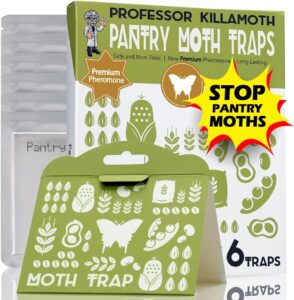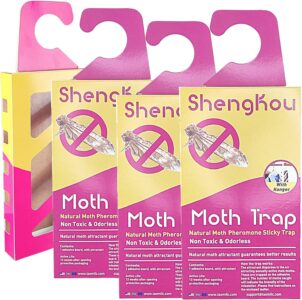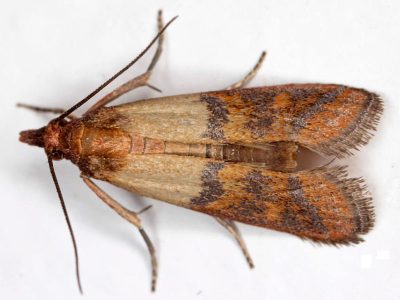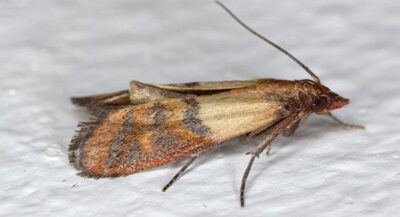Pantry moth infestations threaten your food storage areas with contamination and waste. The right pantry moth trap provides effective monitoring and control, helping you detect problems early and eliminate these persistent pests. Our comprehensive guide covers the most effective pantry moth traps available, from pheromone-based solutions to DIY options, ensuring you can protect your pantry and reclaim your peace of mind.
Quick Picks: Best Pantry Moth Traps
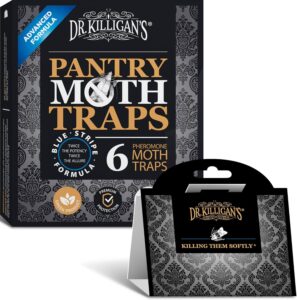
Editor’s Choice
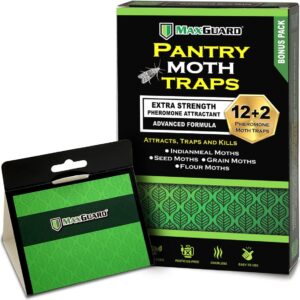
Best Value
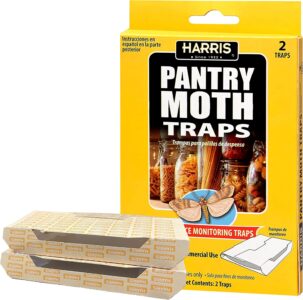
Most Discreet
- Understanding Pantry Moth Infestations
- How Pantry Moth Traps Work
- 5 Essential Features of Effective Pantry Moth Traps
- DIY Pantry Moth Trap Alternative
- Comprehensive Pantry Moth Control Strategy
- Trap Placement and Monitoring Best Practices
- Troubleshooting Common Trap Issues
- Cost-Benefit Analysis of Pantry Moth Traps
- When to Call Professional Pest Control
- Frequently Asked Questions
- Conclusion
Understanding Pantry Moth Infestations
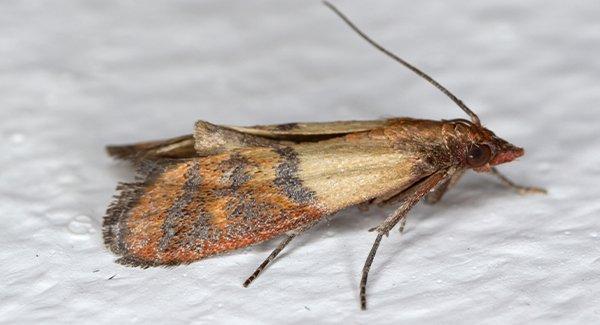
Pantry moths, primarily the Indian meal moth (Plodia interpunctella), represent one of the most common and frustrating household pest problems. These small moths infest stored food products, contaminating cereals, grains, flour, nuts, dried fruits, and even pet food with their larvae, webbing, and waste products.
According to the Colorado State University Extension, pheromone traps are “very useful for identifying hot spots of infestation” and work most effectively when combined with proper sanitation and food storage practices. Understanding how to identify an infestation early allows for faster, more effective intervention.
Recognizing Signs of Pantry Moth Activity
Early detection is crucial for preventing small problems from becoming major infestations. Watch for these telltale signs in your pantry and food storage areas:
Adult Moths
Small moths measuring 1/2 to 5/8 inch long with distinctive gray or tan wings featuring coppery tips. Often seen flying in zigzag patterns around the kitchen, especially at dusk.
Larvae & Webbing
Cream-colored worms found in food packages, crawling on shelves, or near ceilings. They produce silk webbing that clumps food together and creates web-like structures in corners.
Damaged Products
Food packages with holes, tunnels, or clumped contents. Look for small dark droppings (frass) and silken threads throughout affected products.
Pupae & Cocoons
Small cylindrical cocoons in hidden corners, crevices, or along cabinet edges. Larvae often travel away from food sources to pupate in undisturbed areas.
Pantry moth larvae can travel significant distances from their food source before pupating. If you find cocoons on ceilings or in rooms adjacent to your pantry, you likely have an established infestation requiring immediate attention.
How Pantry Moth Traps Work
Modern pantry moth traps utilize pheromone technology to attract and capture adult male moths. The National Pesticide Information Center explains that pheromones are chemical signals insects naturally produce to communicate, making pheromone-based traps highly effective at attracting target pests while remaining completely safe around food.
The Science Behind Pheromone Attraction
Female pantry moths release sex pheromones to attract males for mating. Commercial traps mimic these pheromones using synthetic compounds, creating an irresistible lure for male moths. When males are attracted to the trap, they become stuck on the adhesive surface, preventing them from mating with females and breaking the reproductive cycle.
Pheromone traps capture only male moths. While this significantly reduces reproduction, traps work best as monitoring tools within a comprehensive pest management strategy rather than as a standalone solution for severe infestations.
Trap Effectiveness and Limitations
According to the Colorado State Extension, while pheromone traps excel at identifying infestation “hot spots,” their ability to completely control pantry moth populations is limited because they only capture males, and usually only a fraction of the male population. This makes them invaluable for:
- Early Detection: Identifying moth presence before visible damage occurs
- Monitoring Severity: Gauging infestation size based on trap captures
- Tracking Progress: Measuring control method effectiveness over time
- Locating Sources: Pinpointing which areas harbor the most moths
5 Essential Features of Effective Pantry Moth Traps
The best pantry moth traps share five critical characteristics that maximize their effectiveness for monitoring and controlling infestations. Selecting traps with these features ensures optimal performance and value.
1. Pheromone Lures
High-quality pheromone attractants form the foundation of effective moth trapping. The best traps use concentrated, double-potent pheromone formulas that attract moths from greater distances and for longer periods.
Dr. Killigan's Premium Pantry Moth Traps
Editor's ChoiceHow Does It Work
How to Use
- Remove trap from packaging and peel off protective backing
- Fold trap into triangular shape according to instructions
- Place in pantry or food storage areas where moth activity has been noticed
- Position traps in quiet areas with good air circulation for maximum effectiveness
- Check traps weekly and replace every 3 months or when full
- Use multiple traps for larger pantries or severe infestations
- Double-potent proprietary pheromone formula for superior attraction
- Industrial-strength adhesive ensures captured moths cannot escape
- Non-toxic and safe for use in food storage areas
- Effective against Indian Meal Moths, Mediterranean Flour Moths, and other pantry moths
- Long-lasting protection for up to 6 months when unopened, 3 months when active
- Two attractive design options that blend with kitchen decor
- Easy triangular fold design for quick setup
- Higher price point compared to generic alternatives
- May require 7-10 days to achieve full effectiveness
- Traps only capture males, requiring comprehensive approach for complete control
Maximizing Pheromone Effectiveness
- Place traps before seeing moths for early detection
- Position in areas with good airflow to disperse pheromones
- Keep traps away from windows and doors where outdoor air dilutes scent
- Replace traps every 3 months or when heavily filled with moths
- Store unused traps in sealed packaging to preserve pheromone potency
2. Superior Sticky Adhesive
The adhesive surface quality directly impacts trap success. Premium traps feature industrial-strength glue that captures moths immediately upon contact and holds them securely without drying out or losing effectiveness over the trap’s active period.
MAXGUARD Pantry Moth Traps with Extra-Strength Pheromones
Best ValueHow Does It Work
How to Use
- Open package and remove protective backing from adhesive
- Fold trap according to printed instructions
- Place in pantry, cupboards, or areas showing moth activity
- Position traps near food storage but away from direct airflow
- Monitor weekly and note any increase in captures
- Replace trap when full or after 3 months of use
- Use multiple traps for comprehensive coverage in large storage areas
- Excellent value with 14 traps per package
- Extra-strength pheromone formula for maximum attraction
- Timed-release technology maintains effectiveness for full 3 months
- Non-toxic and insecticide-free formulation
- Safe for use in food preparation and storage areas
- Effective against multiple pantry moth species
- Simple fold-and-place design requires no assembly
- Design may not be as aesthetically pleasing as premium options
- Adhesive may lose effectiveness in very hot environments
- Individual trap size smaller than some competing products
3. Non-Toxic and Safe Formulation
Safety remains paramount when dealing with pest control in food storage areas. The best pantry moth traps contain no harmful chemicals, pesticides, or toxic substances, making them safe for households with children, pets, and individuals with chemical sensitivities.
Look for traps classified as “minimum-risk” pest products under EPA regulations. These products use ingredients recognized by the federal government to pose little to no risk to human health or the environment. The EPA confirms that pheromone-based traps present minimal safety concerns when used as directed.
Professor Killamoth Pantry Moth Traps
Safest FormulaHow Does It Work
How to Use
- Fold trap into triangle shape as illustrated on packaging
- Ensure pheromone glue area is fully exposed
- Place in pantry or food storage locations
- Position in corners or along shelves where moths have been observed
- Check traps regularly for captured moths
- Replace when trap becomes full or after approximately 3 months
- Completely non-toxic and chemical-free formulation
- Safe for use around children and pets without precautions
- Special pheromone-glue integration for enhanced effectiveness
- Long-lasting performance for up to 3 months
- Simple triangle design for easy placement
- No off-gassing or chemical odors
- Smaller trap surface area than some competitors
- Basic design lacks aesthetic refinement
- May require more frequent replacement in heavy infestations
4. User-Friendly Design
Ease of use significantly impacts trap effectiveness. The best designs require minimal assembly, position easily in tight spaces, and allow for flexible placement options including hanging or shelf mounting.
ShengKou Refillable Dual Moth Pheromone Traps
Most VersatileHow Does It Work
How to Use
- Remove trap from packaging and select appropriate pheromone dispenser
- Attach pheromone dispenser to adhesive board
- Hang trap in affected area using built-in hanger
- Position at moth flight level (typically 3-6 feet high)
- Replace adhesive board when full
- Refill with new pheromone dispensers as needed
- Dual-purpose design for both pantry and clothes moths
- Refillable system reduces long-term costs
- Convenient hanger design for versatile placement
- Easy to reposition and relocate as needed
- Cost-effective solution for multiple moth species
- Premium adhesive boards with strong holding power
- Requires purchasing replacement pheromones and boards separately
- Hanger design may not fit all storage configurations
- Initial cost higher than disposable alternatives
5. Long-Lasting Effectiveness
Trap longevity affects both convenience and cost-effectiveness. Premium traps maintain full pheromone potency and adhesive strength for three months or longer, providing continuous protection without frequent replacement.
Harris Pantry Moth Traps - Professional Strength
Most DiscreetHow Does It Work
How to Use
- Fold trap according to simple printed instructions
- Place on pantry shelves or mount in cabinets
- Position in areas where moths are most active
- Leave undisturbed for optimal monitoring results
- Check trap weekly to assess moth activity levels
- Replace every 3 months for continuous protection
- Sleek, modern design appropriate for visible placement
- Professional-strength formula rivals commercial products
- Long-lasting 3-month effectiveness
- Suitable for both residential and commercial settings
- Easy fold design requires no assembly
- Discreet appearance doesn't advertise pest problems
- Only 2 traps per package may require multiple purchases
- Higher per-trap cost than bulk alternatives
- Design may be too large for very small storage spaces
DIY Pantry Moth Trap Alternative
For budget-conscious homeowners or those facing immediate moth problems without commercial traps available, creating a simple DIY pantry moth trap provides temporary monitoring and capture capability.
Homemade traps lack the powerful pheromone attractants found in commercial products and typically prove less effective for serious infestations. Use DIY traps as supplementary monitoring tools or temporary solutions until you can obtain professional-grade traps.
Simple Vinegar Trap Recipe
This basic trap uses ingredients commonly available in most households and takes just minutes to assemble.
Materials Needed
- Shallow bowl or container
- Apple cider vinegar (1/4 cup)
- Liquid dish soap (few drops)
- Plastic wrap
- Rubber band or tape
- Toothpick or pin
Assembly Steps
- Pour vinegar into container
- Add several drops of dish soap
- Cover tightly with plastic wrap
- Secure with rubber band
- Poke small holes in plastic
- Place in affected areas
How the DIY Trap Works
The vinegar scent attracts moths, which enter through the holes in the plastic wrap. The dish soap breaks the surface tension of the liquid, preventing moths from escaping and causing them to drown. While less effective than pheromone traps, this method can capture some moths and help you gauge infestation severity.
DIY vinegar traps attract moths through general food scents rather than targeted pheromones. They may also attract fruit flies and other insects, making it difficult to accurately assess pantry moth populations. For reliable monitoring and control, invest in commercial pheromone traps.
Comprehensive Pantry Moth Control Strategy
Traps alone cannot eliminate established pantry moth infestations. The EPA recommends using Integrated Pest Management (IPM) approaches that combine monitoring tools like pheromone traps with preventive measures for the most effective long-term control.
Essential Control and Prevention Steps
Implement these comprehensive strategies alongside trap usage for complete pantry moth elimination:
- Thorough Inspection and Removal: Examine all stored food products for signs of infestation including webbing, larvae, or adult moths. Discard infested items in sealed plastic bags and remove them from your home immediately to prevent reinfestation.
- Deep Cleaning Protocol: Empty pantry completely and vacuum all surfaces, paying special attention to corners, cracks, and crevices where eggs and larvae hide. Wash shelves with soap and hot water, then dry thoroughly before returning items.
- Proper Food Storage: Transfer all susceptible items including grains, cereals, flour, nuts, dried fruits, and pet food into airtight glass, metal, or heavy-duty plastic containers with secure lids. This prevents moths from accessing food and contains any existing infestations.
- Temperature Treatment: For items you want to save, freeze them at 0°F for at least four days to kill all life stages, or heat in the oven at 140°F for one hour. This effectively eliminates eggs, larvae, and pupae without using chemicals.
- Natural Deterrents: Place bay leaves, whole cloves, or lavender sachets in pantry areas as additional repellents. While not elimination methods, these natural deterrents may help discourage moth activity in conjunction with other control measures.
- Regular Monitoring: Maintain active pheromone traps in your pantry even after eliminating visible moths. Traps provide early warning of new infestations, allowing intervention before problems escalate.
- Incoming Product Inspection: Carefully examine all new food purchases before storing them in your pantry. Look for signs of moth activity and consider freezing bulk purchases for several days before storage as a preventive measure.
Creating a Moth-Proof Pantry
Preventing future infestations requires ongoing vigilance and proper food storage practices:
| Prevention Strategy | Effectiveness | Implementation Difficulty | Cost |
|---|---|---|---|
| Airtight Container Storage | Very High | Easy | $-$$ |
| Regular Inspection & Rotation | High | Easy | $ |
| Pheromone Trap Monitoring | High | Very Easy | $ |
| Temperature Treatment | Very High | Moderate | $ |
| Deep Cleaning Schedule | Moderate | Moderate | $ |
| Natural Repellents | Low to Moderate | Easy | $ |
Trap Placement and Monitoring Best Practices
Proper trap placement significantly impacts effectiveness. The National Pesticide Information Center recommends strategic positioning to maximize moth capture and provide accurate infestation assessment.
Optimal Trap Location Guidelines
Strategic Placement Tips
- Height Positioning: Place traps at moth flight level, typically 3-6 feet high on shelves or hanging from upper cabinet areas
- Quiet Areas: Moths prefer undisturbed spaces, so position traps in corners and low-traffic areas of pantries
- Away from Light: Keep traps from direct sunlight and bright lights, as moths are nocturnal and avoid well-lit areas
- Good Airflow: Ensure adequate air circulation around traps to disperse pheromones effectively throughout the space
- Multiple Locations: Use one trap per storage area or pantry section for comprehensive monitoring
- Near Problem Areas: Place additional traps near areas showing heaviest infestation signs
Monitoring and Record Keeping
Systematic trap monitoring helps track infestation progress and evaluate control measure effectiveness:
Check traps weekly and maintain a simple log noting the date, location, and number of moths captured. Increasing captures may indicate a new infestation source or ineffective control measures requiring additional intervention. Decreasing captures over several weeks suggest successful elimination efforts.
When to Replace Traps
Replace pantry moth traps under these circumstances:
- After 3 months of use, even if not full (pheromone potency decreases over time)
- When trap surface becomes heavily covered with moths (usually 15-20 moths)
- If adhesive appears dried out or loses stickiness
- When trap becomes damaged or dislodged from its position
- After successful elimination of infestation (install fresh traps for monitoring)
Troubleshooting Common Trap Issues
Even the best traps occasionally face performance issues. Understanding common problems and solutions ensures optimal trap effectiveness throughout your moth control campaign.
Trap Captures No Moths
Possible Causes: Trap placed in poor location, pheromone expired, or no active infestation present.
Solutions: Relocate trap to quieter area, check expiration date, wait 7-10 days for pheromone to fully activate, or celebrate if no moths are present!
Captures Increase Over Time
Possible Causes: New infestation source, eggs hatching, or moths migrating from other areas.
Solutions: Intensify inspection efforts, check recently purchased foods, clean all storage areas thoroughly, and add more traps.
Wrong Insects Captured
Possible Causes: Multiple pest species present or non-target insects attracted to trap.
Solutions: Identify captured insects (compare to online resources), address other pest problems separately, or reposition traps away from non-target species.
Infestation Returns Quickly
Possible Causes: Missed infested food source, inadequate cleaning, or new contaminated products introduced.
Solutions: Conduct more thorough inspection, focus on overlooked areas, implement stricter food storage protocols, and freeze bulk purchases before storage.
Cost-Benefit Analysis of Pantry Moth Traps
Understanding the true cost of pantry moth traps versus the losses from food contamination helps justify investment in quality control products.
Financial Impact of Pantry Moth Infestations
Consider these potential costs when dealing with pantry moths:
| Cost Category | Minor Infestation | Moderate Infestation | Severe Infestation |
|---|---|---|---|
| Contaminated Food Loss | $50-$150 | $150-$400 | $400-$1,000+ |
| Replacement Containers | $30-$75 | $75-$150 | $150-$300 |
| Traps & Control Products | $20-$50 | $50-$100 | $100-$200 |
| Professional Extermination | N/A | $200-$400 | $400-$800 |
| Total Estimated Cost | $100-$275 | $475-$1,050 | $1,050-$2,300+ |
Early detection through continuous trap monitoring can prevent minor problems from escalating into costly major infestations, making quality traps an excellent investment.
When to Call Professional Pest Control
While traps and DIY methods handle most pantry moth problems, certain situations warrant professional intervention:
- Infestations persist after 3 months of comprehensive control efforts
- Moths appear in multiple rooms or throughout entire home
- You discover structural damage from larvae (holes in walls, cabinets)
- Commercial or food service settings require certified pest management
- Health concerns or regulations prohibit DIY pest control methods
- Trap captures continuously increase despite rigorous control measures
Professional pest control operators have access to commercial-grade products and advanced application methods not available to consumers. They can also identify contributing factors you might overlook and provide comprehensive treatment plans for severe infestations.
Safe Disposal of Used Traps
Dispose of used pantry moth traps by sealing them in a plastic bag and placing them in regular household trash. The trapped moths are dead and pose no reinfestation risk. No special handling or disposal procedures are necessary due to the non-toxic nature of pheromone traps.
Frequently Asked Questions
How long does it take for pantry moth traps to work?
Pheromone traps begin attracting moths immediately upon placement, but you should allow 7-10 days for the pheromone to fully disperse throughout your storage area. Most users see captured moths within the first week, though this depends on infestation severity.
If you see no moths after two weeks, either your trap is poorly positioned, the pheromone has expired, or you may have successfully eliminated your infestation. Try relocating the trap to a different area before concluding moths are absent.
Can pantry moth traps eliminate an infestation by themselves?
No, traps alone cannot eliminate established infestations because they only capture male moths and usually only a fraction of the male population. Traps work best as monitoring tools within a comprehensive integrated pest management program.
For complete elimination, you must combine traps with thorough cleaning, proper food storage in airtight containers, and removal of all infested products. Traps help you monitor progress and catch any remaining males to reduce reproduction.
How many traps do I need for my pantry?
For standard kitchen pantries (6-8 shelves), use 1-2 traps. Walk-in pantries require 3-4 traps, while large basement storage areas may need 4-6 traps for comprehensive coverage.
As a general rule, place one trap per 50-100 square feet of storage space. For severe infestations, increase trap density to one per 25 square feet until moth captures decrease significantly.
Are pantry moth traps safe around food?
Yes, pantry moth traps are completely safe for use in food storage areas. They contain no toxic chemicals or pesticides—only synthetic pheromones that affect moths and a food-grade adhesive. The pheromones are species-specific and pose no risk to humans, pets, or food products.
According to the EPA, pheromone-based monitoring tools present minimal safety concerns when used as directed and are classified as “minimum-risk” pest control products.
Why am I catching more moths over time instead of fewer?
Increasing trap captures typically indicate one of three scenarios: eggs are hatching from a hidden infestation source you haven’t found, you’ve introduced new contaminated products, or moths are migrating from adjacent rooms or neighboring units.
Conduct a more thorough inspection focusing on overlooked items like pet food, birdseed, decorative dried goods, and old food in rarely-used cabinets. Also examine recently purchased products, especially bulk items from bins or discount stores.
Can I use pantry moth traps for other types of moths?
Pantry moth traps are specifically designed for food-infesting moths like Indian meal moths, Mediterranean flour moths, and almond moths. They will not attract or capture clothes moths, which are an entirely different species requiring separate pheromone formulations.
Some products like the ShengKou traps feature dual pheromone dispensers that work for both pantry moths and clothes moths, providing versatile protection throughout your home.
Do pantry moth traps work on larvae and eggs?
No, pheromone traps only attract and capture adult male moths. They have no effect on eggs, larvae (worms), or pupae. This is why traps must be combined with other control methods like removing infested food, thorough cleaning, and temperature treatment to eliminate all life stages.
The trapped males cannot mate with females, which gradually reduces the population, but existing eggs and larvae will still mature into adults over several weeks.
How should I store unused pantry moth traps?
Keep unopened traps in their sealed packaging in a cool, dry location away from direct sunlight. Most quality traps maintain full potency for 2-3 years when stored properly. Check the packaging for specific expiration dates or manufacturing dates.
Never remove traps from their protective packaging until you’re ready to use them, as exposure to air begins the pheromone release and adhesive activation process.
Conclusion
Effective pantry moth control requires understanding the pest, selecting quality traps with proven features, and implementing comprehensive prevention strategies. The best pantry moth traps combine powerful pheromone attractants, superior adhesive, non-toxic formulations, user-friendly designs, and long-lasting effectiveness to provide reliable monitoring and population reduction.
- Pheromone traps excel as monitoring tools but must be combined with sanitation and proper food storage for complete control
- Quality traps with double-potent pheromones and industrial-grade adhesive outperform cheaper alternatives
- Early detection through continuous trap monitoring prevents minor problems from becoming costly major infestations
- Strategic trap placement in quiet, dark areas at moth flight level maximizes effectiveness
- Regular monitoring and record-keeping helps track progress and identify new infestation sources
By implementing the strategies outlined in this guide and selecting traps with the five essential characteristics, you can successfully monitor, control, and eliminate pantry moth infestations while protecting your food storage areas from future problems. Remember that persistence and thoroughness are key—pantry moths can be challenging, but with the right tools and comprehensive approach, you can achieve and maintain a moth-free pantry.
